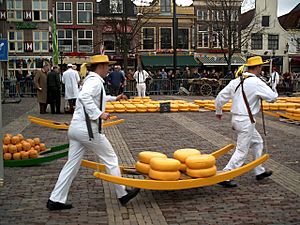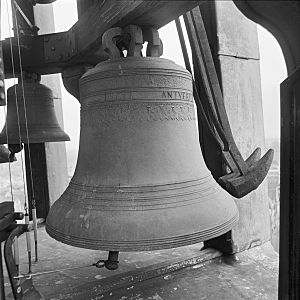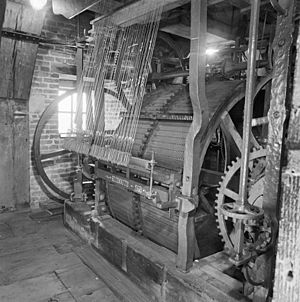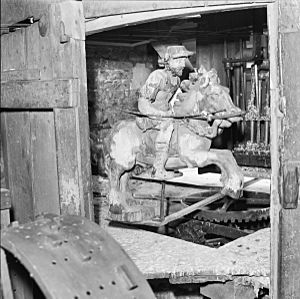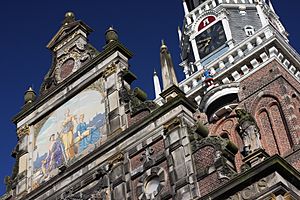Waag (Alkmaar) facts for kids
Quick facts for kids Waag, Alkmaar |
|
|---|---|
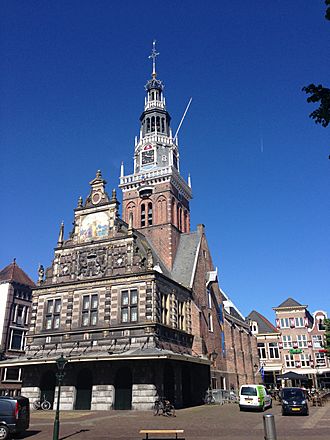
Alkmaar - Waag (Weigh building) on the square Waagplein.
|
|
| Alternative names | Weigh house tower |
| General information | |
| Type | Carillon tower - Weigh house |
| Architectural style | partly Renaissance style. |
| Location | Alkmaar, North Holland |
| Address | Waagplein 2 |
| Completed | 1603 |
| Owner | Gemeente Alkmaar |
| Design and construction | |
| Architect | C.W. Royaards (1960s restoration) |
The Waag building in Alkmaar, Netherlands, is a very old and important building. It's known as a National Monument, which means it's protected because of its history. You can find it in the Waagplein square. Every Friday, from April to September, a famous cheese market happens right outside. Inside the Waag, you'll find the Dutch Cheese Museum and a tourist information office. The building also has a tall tower with a special musical instrument called a carillon. A person called a carillonneur plays it every week. The carillon also plays automatically every 15 minutes. Plus, there's a cool automatic show with horses and knights that plays in the tower!
Contents
What is the Waag Building?
The word "Waag" means "weigh house" in Dutch. This building was used to weigh goods, especially cheese, for trade. It's a key part of Alkmaar's history and culture.
How Old is the Waag Building?
The Waag building has a long and interesting past. It started out in the 1300s as a chapel for a hospital. This hospital, called the Holy Spirit hospital, helped poor travelers and sick people. They could stay for free for a few days.
In 1566, the hospital got permission to use the building for weighing things. By 1582, all the weighing activities moved into the larger chapel. It was no longer used for church services then.
Alkmaar's Famous Cheese Market
The weekly cheese market is a big event held right next to the Waag building. Long ago, people traded Edam and Gouda cheeses here. Today, it's mostly a fun show for tourists from all over the world. You can still see how cheese was traditionally sold. There are also other items for sale along the nearby canal called Mient.
How the Chapel Became a Weigh House
The chapel was changed into a weigh house in 1583. They made the outside of the building a bit smaller. The back part of the chapel was removed. A beautiful new front, called a façade, was added in a style called Renaissance. You can still see the outline of the old chapel on the ground next to the building. The current fancy front was built in 1884, but it looks very much like the original design. From 1597 to 1603, the old tower was replaced with the much bigger one you see today. This is the present Waagtoren.
What Does the Latin Proverb Mean?
Look up at the front of the building, and you'll see a Latin saying. It says: "SPQA RESTITVIT VIRTVS ABLATAE JVRA BILANCIS". This long phrase means: "The Council and People of Alkmaar, by their bravery and strength, brought back the right to have a weigh house."
This saying refers to an important battle against Spanish Roman Catholics. After a peace agreement in 1573, the citizens of Alkmaar got their rights back. This included the right to have their own weigh house.
The Carillon and Other Bells
The Waag tower is home to a special musical instrument called a carillon. It's made of many bells that can be played like a piano.
The Carillon Today
The carillon in the tower was first put there in 1688. It was made by a bell maker named Melchior de Haze. Over time, many of the bells got damaged by air pollution. Only nine of the original bells could still be used.
In 1967, a new carillon was installed. It used the remaining old bells and added many new ones. These new bells were made by Royal Eijsbouts in the Netherlands. Now, the carillon has 47 bells! The biggest bell weighs about 1375 kilograms (that's over 3000 pounds!).
- There's also an old de Haze bell from a nearby church hanging in the tower. It's just for decoration now.
- Beneath the clock, you'll find the "gate bell." It was made in 1616. This bell used to signal when the city gates were closing for the night or opening in the morning.
History of the Bells
Before the current carillon, there was an older, smaller set of 11 bells. These were made in the 1540s. More bells were added later. Back then, tuning bells perfectly was very difficult. So, many bells didn't sound quite right.
Later, in the 1640s, two brothers named Hemony became experts at tuning bells. Alkmaar wanted a well-tuned set of bells too. After some challenges with other bell makers, Melchior de Haze was chosen. He made a carillon with 35 bells in 1688. These bells were approved and sent to Alkmaar. The city carillonneur played them for the first time on October 26, 1688.
Some of the bells that were originally made for Alkmaar but not used here ended up in Prague! They are now part of an old carillon in the Loreto convent in the Czech Republic.
The Carillon After 1900
Around 1900, some bells in the carillon cracked. They were repaired or replaced, but the sound wasn't quite right. In 1960, it was decided to completely fix the carillon. This led to the new carillon we have today. Between 2006 and 2013, big repairs were done to the tower and the carillon. The automatic drum, which plays the bells, was also improved.
Other Carillons in Alkmaar
Alkmaar has other carillons that are connected to the Waag's history.
- Twelve old bells from the Waag tower are now used in the Great (St. Laurens) Church.
- Two bells from the Waag and 21 bells from de Haze (from the Waag and the Great Church) are in the Kapelkerk (Chapel Church). This carillon also has an automatic drum.
The Clock and Automatic Drum
The main clock in the tower was made in 1541. The large music cylinder, called a "drum," was added around 1690. This drum makes the bells chime every 15 minutes. At the half and full hour, the largest bell strikes. This is called "Hollandse slag" (Dutch strike).
The drum plays a short tune every quarter of an hour, day and night. This tradition started in the 1540s so people could always know the time. The city carillonneur changes the melodies on the drum twice a year. This involves moving small pins on the drum that lift the hammers to hit the bells.
The Trumpet Player and Knights
A very famous part of this tower is the "ruiterspel," or "rider's game." When the hour strikes, figures of knights on horseback perform a battle scene. Above them, a wooden trumpeter blows his trumpet. He plays an automatic melody several times a day after the full hour.
The trumpet sound comes from a small drum that plays a tiny organ. This organ is hidden behind the riders. Because of temperature changes, the city carillonneur has to tune this little organ regularly. The melody played by the trumpet player can also be changed, just like the big carillon drum.
Carillon Concerts
You can hear the city carillonneur play concerts on the carillon every Saturday morning. These concerts are from 11 AM to noon, all year round.
During the cheese market season (April to October), there are extra concerts on Fridays:
- 9:15 AM to 9:45 AM
- 10:45 AM to 11:00 AM
- 11:45 AM to noon
Since 2009, Christiaan Winter has been the official city carillonneur of Alkmaar. In the summer, guest carillonneurs also give concerts on Wednesdays at 4 PM.
Images for kids


